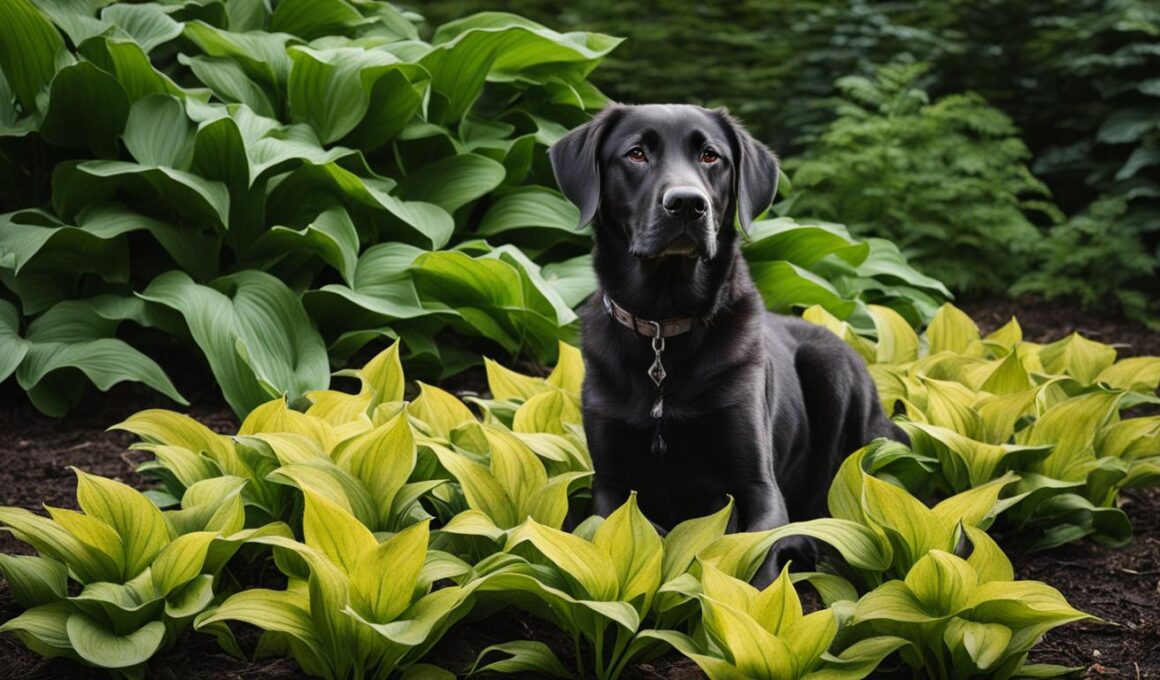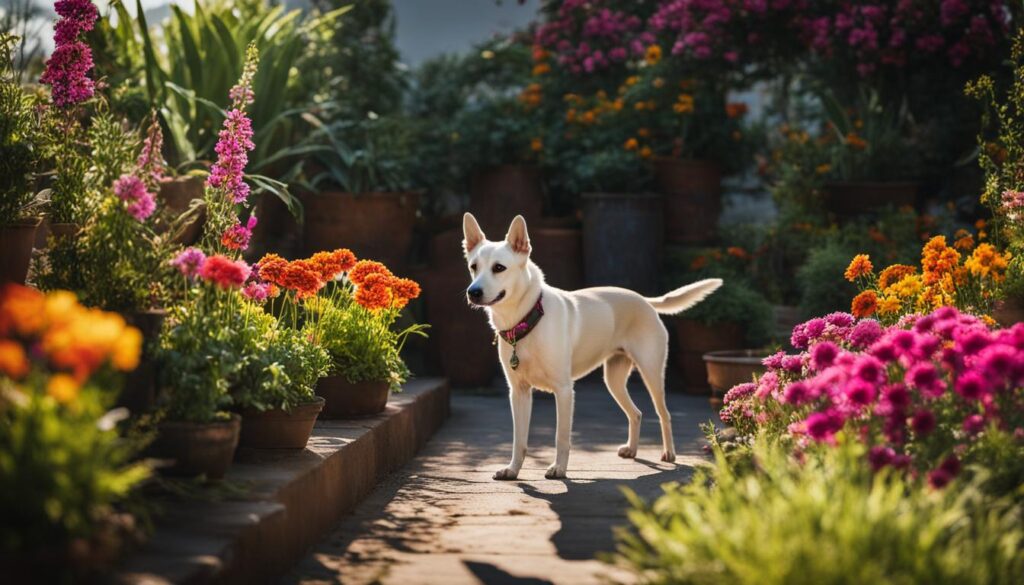When it comes to your beloved furry friend’s health, you want to ensure their safety at all times. As a dog owner, it’s essential to be aware of potential risks that could jeopardize your pet’s well-being. One such risk is the toxicity of hostas, a popular low-maintenance plant found in many gardens.
Hostas can be toxic to dogs, posing a threat to their health if ingested. The toxins responsible for their toxicity are called glycoside saponins, which can have harmful effects on our canine companions. If your dog consumes hostas, they may experience symptoms such as abdominal pain, vomiting, diarrhea, bloating, twisting of the intestines, distress, loss of appetite, and even abnormal heartbeats.
As a responsible dog owner, it’s important to be cautious about your pet’s exposure to hostas. By taking preventive measures and keeping these plants out of your dog’s reach, you can minimize the risk of poisoning. However, accidents can happen, and if you notice any signs of toxicity or suspect that your dog has ingested hostas, it’s crucial to seek immediate veterinary attention.
Stay informed, be vigilant, and prioritize your pet’s safety to ensure many happy and healthy years together!
Other Toxic Plants for Dogs
Apart from hostas, there are several other plants that can be toxic to dogs. It’s important for dog owners to be aware of these plants and take precautionary measures to keep their pets safe.
Lilies: Certain types of lilies, such as star lily, glory lily, and lily of the valley, can be highly toxic to dogs. Ingestion of these plants can lead to kidney and liver failure, shock, and even death.
Daffodils: Daffodils contain toxins in their bulbs, which can cause vomiting, diarrhea, convulsions, low blood pressure, and cardiac arrhythmia if ingested by dogs.
Azaleas: Azaleas, also known as rhododendron, contain a chemical called grayanotoxin. This chemical can cause oral irritation, vomiting, diarrhea, muscle weakness, sudden collapse, and even death if consumed by dogs.
Black Walnuts: While black walnuts themselves are not toxic to dogs, the mold that grows on decomposing nuts can be neurotoxic. Dogs may experience symptoms such as irregular breathing, excess drooling, vomiting, incoordination, tremors, fever, seizures, and liver damage.
Grapes: Grapes and raisins are toxic to both dogs and cats. Ingestion of these fruits can lead to abdominal pain, vomiting, diarrhea, bloating, twisting of the intestines, distress, loss of appetite, and even kidney failure.
Tomato Plants: While ripe tomatoes are safe for dogs, green tomatoes and the plants themselves can be toxic. Ingestion can cause symptoms such as vomiting, diarrhea, seizures, gastrointestinal upset, depression, weakness, and slowed heart rate.
Rhubarb: The leaves of rhubarb contain high levels of oxalic acid. If a dog ingests these leaves, it can result in dehydration, seizures, staggering, lack of appetite, drooling, increased respiratory rate, diarrhea, vomiting, and even coma.
Garlic and Onions: Plants from the Allium family, including garlic, chives, and onions, are toxic to dogs. Ingestion can lead to symptoms like breathlessness, lethargy, diarrhea, vomiting, pale gums, elevated heart rate, increased respiratory rate, weakness, and collapse.
Oleander: Oleander, a commonly grown indoor shrub, contains cardiac glycosides. Ingesting parts of this plant can cause symptoms such as diarrhea, vomiting, mouth irritation, drooling, dilated pupils, elevated heart rate, increased respiratory rate, weakness, and even death.
Aloe: Aloe plants contain saponins, which can cause diarrhea, vomiting, loss of appetite, depression, tremors, and change in urine color if ingested by pets.
Succulents: Some succulents, including the Panda Plant, Jade Plant, Snake Plant, and Kalanchoe, can cause vomiting, drooling, diarrhea, depression, incoordination, and slowed heart rate if consumed by dogs.
Philodendrons: Philodendrons, especially the Heart Shaped Philodendron, can irritate a pet’s mouth with insoluble calcium oxalates if chewed on. This can lead to symptoms such as vomiting, diarrhea, anorexia, lethargy, and weakness.
Poinsettias: Poinsettias have sap that can irritate a pet’s skin or mouth.
To ensure the safety of your four-legged friends, make sure to keep these toxic plants away from their reach and consult with a veterinarian if any accidental ingestion occurs.
Conclusion
Toxic plants can pose a significant threat to the health and safety of our beloved dogs. As responsible pet owners, it is crucial to take proactive measures to prevent plant-related poisoning incidents. Understanding which plants are toxic to dogs, such as hostas, lilies, daffodils, azaleas, black walnuts, grapes, tomato plants, rhubarb, garlic, onions, oleander, aloe, succulents, philodendron, and poinsettia, is the first step in ensuring our furry companions’ well-being.
By keeping these toxic plants out of our dogs’ reach, we can minimize the risk of accidental ingestion and subsequent poisoning. This means avoiding planting them in areas accessible to our pets and being mindful when bringing new plants into our homes or yards. Additionally, regular inspection of our surroundings and prompt removal of any toxic plants that may have sprouted can further enhance pet safety.
However, even with utmost precaution, accidents may happen. If you suspect your dog has ingested a toxic plant or exhibits symptoms of poisoning such as vomiting, diarrhea, abdominal pain, weakness, or abnormal behavior, it is essential to seek immediate veterinary attention. Quick action can make a significant difference in your dog’s recovery and overall well-being.
Remember, prevention is always better than cure. By staying informed, maintaining a safe environment, and promptly addressing any concerning signs, we can safeguard our furry friends from the dangers of toxic plants and ensure their continued happiness and good health.
Can Dogs Be the Culprit Behind My Hostas Being Eaten?
Yes, dogs can be the culprit behind your hostas being eaten. If you notice your hostas being chewed up, consider whether your dog has been the one to blame. Solving the hostaeating mystery might involve keeping your dog away from the garden or installing a fence to protect your plants.










